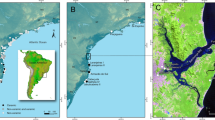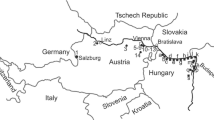Abstract
The Gramalote site is an early Initial Period (1500–1200 B.C.E.) fishing village located in the Moche valley in northern Peru. Previous research assessed the social dynamics and economic interactions within that fishing settlement. The well-preserved animal and plant record facilitates the archeological study of diet and subsistence strategies through time. The examinations of faunal remains of seabirds, sea mammals, and mollusk shells support the expected marine-oriented subsistence strategy. However, the site also contains a long record of botanical remains suggesting that people had access to plant resources. For this reason, a paleoethnobotanical study was conducted with the focus on reconstructing the pollen record of Gramalote. Previously identified botanical remains were also considered. The analysis of diverse botanical proxies helped to study the relationships between humans and plants in this region of northern Peru during the second millennium B.C.E. Grasses; reeds; food, woody, and wild plants were identified suggesting an environment that allowed small-scale agriculture and a trading network during the Initial Period of Gramalote.
El sitio Gramalote representa una comunidad de pescadores del Periodo Inicial temprano (1500–1200 cal A.E.C.) que se localizó en el valle Moche del norte peruano. Investigaciones previas se enfocaron en las interacciones económicas y sociales entre dicha comunidad. La buena preservación del record botánico y animal facilitó el estudio arqueológico de dieta y estrategias de subsistencia de los pescadores a través del tiempo. El análisis de restos de aves marinas, mamíferos marinos, y moluscos sugiere una estrategia de subsistencia marina. Sin embargo, el sitio también contiene un amplio record de restos botánicos sugiriendo que la comunidad de pescadores tuvo acceso a recursos de origen vegetal. Por esta razón, un análisis paleoetnobotánico se llevó a cabo con el objetivo de reconstruir el record palinológico de Gramalote. Restos botánicos previamente identificados también fueron considerados. El análisis de diversos restos botánicos ayudó a estudiar las relaciones entre humanos y plantas en esta región del Perú durante el segundo milenio A.E.C. Grases; cañas; plantas comestibles, maderables y silvestres fueron identificados sugiriendo un ambiente que permitió una agricultura a menor escala y una red de intercambios durante el Periodo Inicial de Gramalote.




Similar content being viewed by others
Literature Cited
Adam, D. P. and P. J. Mehringer. 1975. Modern pollen surface samples: An analysis of subsamples. Journal of Research of the U.S Geological Survey 3: 733–736.
Bellwood, P. S. 2005. The first farmers: The origins of agricultural societies. Malden: Blackwell Pub.
Bohrer, V. L. 1981. Methods of recognizing cultural activity from pollen in archaeological sites. Kiva 46: 135–142.
Bonavia, D. 1982. Precerámico peruano. Los Gavilanes. Mar, desierto y oásis en la historia del hombre. Lima: Corporación Financiera de Desarrollo S.A. COFIDE and Instituto Arqueológico Alemán.
-----, V. F. Vásquez, T. Rosales, T. D. Dillehay, P. J. Netherly, and K. Benson. 2017. Plant Remains. In: Where the land meets the sea: fourteen millennia of human history at Huaca Prieta, Peru, ed. T. D. Dillehay, 367–433. Austin: University of Texas Press.
Brack, A. J. 1999. Diccionario enciclopédico de plantas útiles del Perú. Cuzco: Centro de Estudios Regionales Andinos “Bartolomé de Las Casas”.
-----. 2003. Frutas del Perú. Lima: Universidad San Martin de Porres.
Brako, L. and J. L. Zarucchi. 1993. Catalogue of the flowering plants and gymnosperms of Peru. Saint Louis: The Missouri Botanical Garden.
Briceño, J. and B. Billman. 2008. Gramalote y el Periodo Inicial en el valle de Moche. Nuevos datos de un viejo sitio de pescadores. Revista del Museo de Arqueología, Antropología e Historia 10: 175–208.
Bryant, V. M. and S. A. Hall. 1993. Archaeological palynology in the United States: A critique. American Antiquity 58: 277–286.
----- and R. G. Holloway. 1983. The role of palynology in archaeology. Advances in Archaeological Method and Theory 6: 191–224.
-----, -----, J. G. Jones, and D. L. Carlson. 1994. Pollen preservation in alkaline soils of the American Southwest. In: Sedimentation of organic particles, ed. A. Traverse, 47–58. Cambridge: Cambridge University Press.
Burger, R. L. 1992. Chavin and the origins of Andean civilization. New York: Thames and Hudson.
Cogollo, K. A., V. F. Barraza, and C. M. Gary. 2008. Bondades del fruto del jaboncillo (Sapindus saponaria) como un detergente biodegradable. Barranquilla: Instituto Alexander Von Humboldt.
Dean, G. W. 1991. Archaeobotanical analysis of pollen and phytolith samples from prehistoric structural and agricultural features at LA 2742, LA 70577, LA 71189, and LA 71190, Pot Creek Project, Taos Country, New Mexico. Report number 303. Albuquerque: Castetter Laboratory for Ethnobotanical Studies.
Dillehay, T. D. and D. R. Piperno. 2014. Agricultural origins and social implications in South America. In: The Cambridge world prehistory, eds. C. Renfrew, and P. Bahn, 970–985. Cambridge: Cambridge University Press.
Dillehay, T. D., J. Rossen, T. C. Andres, and D. E. Williams. 2007. Preceramic adoption of peanut, squash, and cotton in northern Peru. Science 316(5833): 1890–1893.
Erdtman, G. 1960. The acetolysis method. A revised description. Svensk Botanisk Tidskrift 54: 561–564.
Gepts, P. 2004. Crop domestication as a long-term selection experiment. Plant Breeding 24(2): 1–44.
Glyan’ko, A. K. 2015. Signaling systems of rhizobia (Rhizobiaceae) and leguminous plants (Fabaceae) upon the formation of a legume-rhizobium symbiosis (Review). Applied Biochemistry and Microbiology 51: 494–504.
Godwin, H. 1934. Pollen analysis. An outline of the problems and potentialities of the method. Part II. General applications of pollen analysis. The New Phytologist 33(5): 325–358.
Haas, J., W. Creamer, L. Huamán, D. Goldstein, K. Reinhard, and C. Vergel. 2013. Evidence for maize (Zea mays) in the Late Archaic (3000–1800 B.C.E.) in the Norte Chico region of Peru. Proceedings of the National Academy of Sciences of the United States of America 110: 4945–4949.
Hansen, B. C. S., G. O. Seltzer, and H. E. Wright. 1994. Late Quaternary vegetational change in the Central Peruvian Andes. Palaeogeography, Palaeoclimatology, Palaeoecology 109: 263–285.
Hastings, C. M. 1973. Field Notes Diary. Chan-Chan, Moche Valley Project Archives. Cambridge: Peabody Museum Archives, Harvard University.
Horn, S. P., J. I. Rodgers, K. H. Orvis, and L. A. Northrop. 1998. Recent land use and vegetation history from soil pollen analysis: Testing the potential in the lowland humid tropics. Palynology 22: 167–180.
Huamán, L. 2016. Catálogo de Pólenes del Perú. Laboratorio de Palinología y Paleobotánica. Lima: Universidad Peruana Cayetano Heredia.
Jarosz, N., B. Loubet, B. Durand, A. McCartney, X. Foueillassar, and L. Huber. 2003. Field measurements of airborne concentration and deposition rate of maize pollen. Agricultural and Forest Meteorology 119: 37–51.
Larson, G., D. R. Piperno, R. G. Allaby, M. D. Purugganan, L. Anderson, M. Arroyo-Kalin, L. Barton, et al. 2014. Current perspectives and the future of domestication studies. Proceedings of the National Academy of Sciences 111(17): 6139–6146.
Moseley, M. 1975. The maritime foundations of Andean civilization. Menlo Park: Cummings Publishing Company.
Nesbitt, J. 2012. Excavations at Caballo Muerto: An investigation into the origin of the Cupisnique culture. Ph.D. thesis, Yale University, New Haven, Connecticut.
O’Rourke, M. K. 1986. The implications of atmospheric pollen rain for fossil pollen profiles in the arid Southwest. Ph.D. thesis, University of Arizona, Tucson, Arizona.
Pearsall, D. M. 2015. Paleoethnobotany: a handbook of procedures. Third edition. Walnut Creek: Left Coast Press.
Piperno, D. R. 2011. The origins of plant cultivation and domestication in the New World tropics. Current Anthropology 52(4): 453–470.
----- and T. D. Dillehay. 2008. Starch grains on human teeth reveal early broad crop diet in northern Peru. Proceedings of the National Academy of Sciences of the United States of America 105(50):19622–19627.
----- and D. M. Pearsall. 1998. The origins of agriculture in the lowland neotropics. San Diego: Academic Press.
Pozorski, T. 1976. Caballo Muerto: A complex of Early Ceramic Sites in the Moche Valley, Peru. Ph.D. thesis, The University of Texas, Austin, Texas.
Pozorski, S. G. 1979. Prehistoric diet and subsistence of the Moche Valley, Peru. World Archaeology 11:163–184.
———. 1982. Subsistence systems in the Chimú state. In: Chan Chan, Andean desert city, eds. M. E. Moseley, and K. C. Day, 177–196. Albuquerque: University of New Mexico Press.
----- and T. Pozorski. 1979. An early subsistence exchange system in the Moche Valley, Peru. Journal of Field Archaeology 6:413–432.
Prieto, G. 2014. The Early Initial Period fishing settlement of Gramalote, Moche Valley: A preliminary report. Peruvian Prehistory 1:1–46.
———. 2015. Gramalote: Domestic life, economy and ritual practices of a Prehispanic maritime community. Ph.D. thesis, Yale University, New Haven, Connecticut.
Quilter, J. and T. Stocker. 1983. Subsistence economies and the origins of Andean complex societies. American Anthropologist 85(3): 545–562.
Rondón, X. J., S. A. Banack, and W. Diaz-Huamanchumo. 2003. Ethnobotanical investigation of Caballitos (Schoenoplectus californicus: Cyperaceae) in Huanchaco, Peru. Economic Botany 57(1): 35–47.
Rossen, J. 2011. Preceramic plant gathering, gardening and farming. In: From foraging to farming in the Andes: New perspectives on food production and social organization, ed. T. Dillehay, 177–192. Cambridge: Cambridge University Press.
Sandweiss, D. H. 2009. Early fishing and inland monuments: Challenging the maritime foundations of Andean civilization? In: Andean civilization: A tribute to Michael E. Moseley, eds. J. Marcus, and P. R. Williams, 39–54. Los Angeles: Cotsen Institute of Archaeology, University of California.
Shady, R. M. 2006. America’s first city? The case of Late Archaic Caral. In: Andean archaeology III. North and south, eds. W. H. Isbell and H. Silverman, 28–66. Berlin: Springer.
Sorensen, M., S. Doygaard, J. E. Estrella, L. P. Kvist, and P. E. Nielsen. 1997. Status of the south American tuberous legume Pachyrhizus tuberosus (Lam.) Spreng. Biodiversity and Conservation 6:1581–1625.
The Plant List. 2017. The plant list database. http://www.theplantlist.org/.
Ubillus, G. 2014. Informe del estudio de los restos macro-botánicos del sitio Gramalote. Temporada 2011–2012. Proyecto Arqueológico Pampas Gramalote.
Velásquez, P. 1987. Recursos marinos y vegetales durante el Formativo Temprano en el sitio de Gramalote, sector Huanchaquito: Valle de Moche. Trujillo: Universidad Nacional de Trujillo.
Villanueva, F. 2014 Reconstrucción paleoambiental del sitio arqueológico Pampas Gramalote basada en microrestos (La Libertad- Perú). Lima: Universidad Nacional Federico Villarreal.
Whitaker, T. W. 1983. Cucurbits in Andean prehistory. American Antiquity 48: 576–595.
Winker, R. 2011. Searching for function and social hierarchy at Operación VI, Caballete, Norte Chico Region, Peru. M.A. thesis, Northern Illinois University, DeKalb, Illinois.
Acknowledgments
I would like to express my acknowledgments to Dr. Vaughn Bryant who guided me during the laboratory and identification processes and read preliminary versions of this manuscript. I thank Dr. Allison Hopkins for her comments and suggestions during the preparation of this manuscript. In addition, I wish to express my gratitude to Dr. Luis Huamán for letting me use his Peruvian pollen collection and helping me in identifying unknown pollen grains. I thank Dr. Gabriel Prieto for facilitating the access to the Gramalote site, Jose Soto for field assistance, and Victor Vargas for his graphic design work.
Funding
This work was supported by a grant from the Anthropology Department at Texas A&M University.
Author information
Authors and Affiliations
Corresponding author
Appendix
Appendix
Rights and permissions
About this article
Cite this article
Paredes, R. Paleoethnobotany of the Early Initial Period of Gramalote in Northern Peru. Econ Bot 72, 94–106 (2018). https://doi.org/10.1007/s12231-018-9402-x
Received:
Accepted:
Published:
Issue Date:
DOI: https://doi.org/10.1007/s12231-018-9402-x




